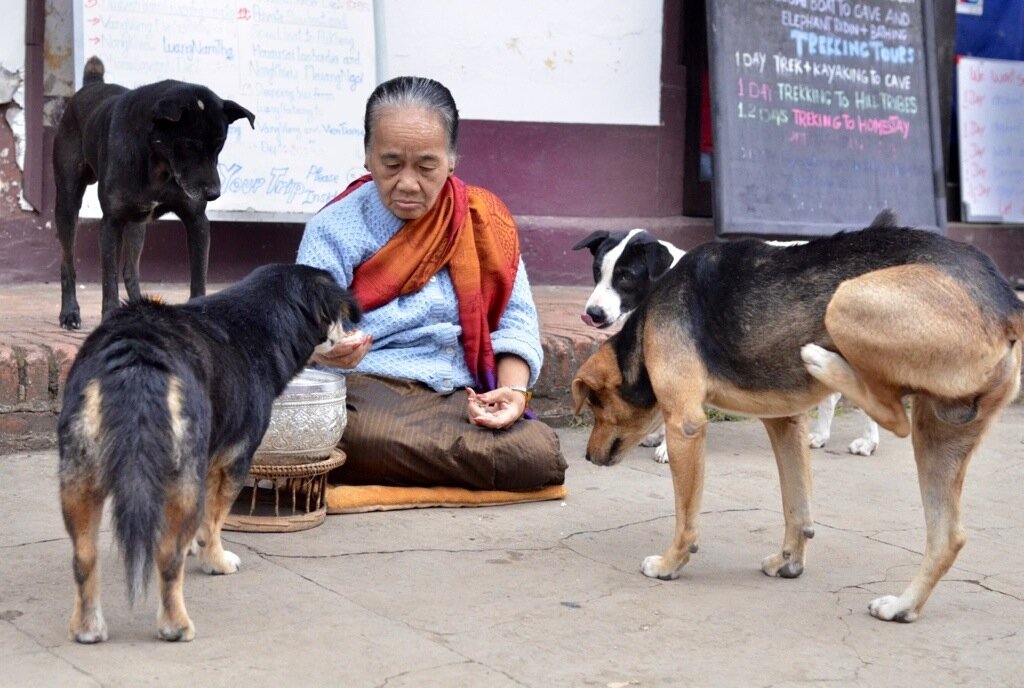Luang Prabang: Mud, Hmong and Monks
Due to a bit of a miscommunication and language barrier our guide arrived without a vehicle to transport us on our day of exploring Luang Prabang's outer environs. So we set off in the rain (atypical for the dry season) to trek to a 'nearby' Hmong village. In fairness to the guide he did ask us in advance if we minded some mud and uphill hiking. The beginning wasn't too bad and in fact David found an enthusiastic welcome committee at an ATM on the main road out of town. "Picture! Picture!" they demanded, and I was delighted to comply.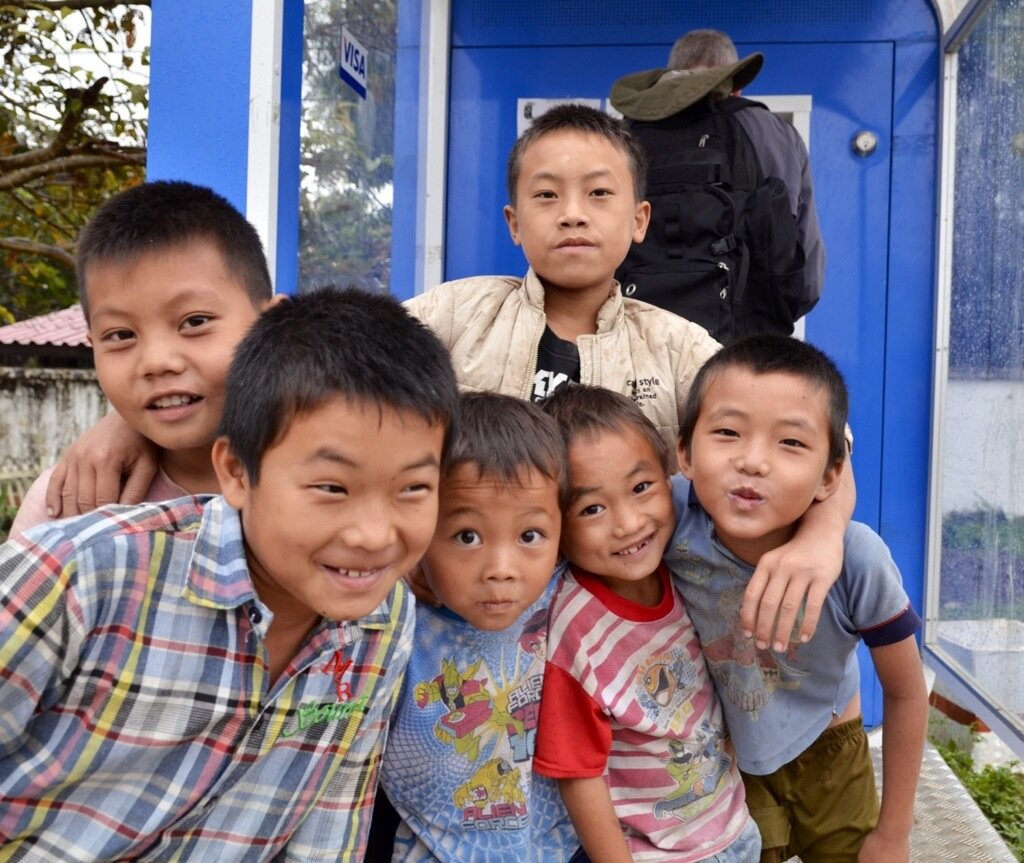 As we progressed I thought of my Aunt Vivian's description of her trip in South America that involved rubber boots sinking into sucking mud, and wished I had some boots of my own. I'm a pretty intrepid hiker and I don't mind most creepy crawly things. Snakes, spiders, lizards - no big deal. However I do have a major problem with leeches (never got over watching Humphrey Bogart being attacked in the African Queen, I guess). While I'd never had any up front and personal experience with leeches, I didn't want to start now."Are there leeches here?" I called out to our guide who was misquoting to David the number of people who lived in Luang Prabang."700,000? Really?, I thought it was more like 70,000..." David said."Excuse me! Are there leeches here?" I called a little more assertively, my Keens sinking further into the mud with every steeply uphill step."Yes, many people are here," he assured David.Frankly, I didn't give a shit about the population of Luang Prabang. I was interested in the leech population. Our experience traveling in Southeast Asia has been that we get a lot of the 'double positive' replies to questions we ask that are either unclear, misunderstood, or to which there is simply no answer: "Yes, yes.""Yes, there are leeches??!!"I guess the desperation in my voice transcended the language barrier and he quickly changed his answer to, "No, no."On we trudged.At last we approached a few dwellings fashioned of corrugated tin, woven straw and cardboard. As it was a school holiday, children were playing outside while their mothers, many with babies in arms, embroidered colorful pieces of cotton. This was a degree of poverty we had not yet seen. Even in the most remote villages we had seen in Myanmar on the Irrawaddy, the standard of living looked better than this. I felt like a total interloper - the stereotypical tourist who goes out to see the natives so they can check that box off their 'to-do/see list.'My degree of discomfort and what I judged the inappropriateness of our being there was multiplied when our guide announced: "OK to take picture!""That's ok, I don't need to take a picture. Actually, I think we should leave." But our guide had said something to the few people there, trying to gather them together for a group shot. They looked as confused as I felt uncomfortable."Ok, now you take," our guide insisted."I can't take a picture without asking permission," I said through gritted teeth."Ok to take," he insisted."You need to ask them first."The villagers looked back and forth at us as if they were at a bizarre tennis match.Finally, he said something to them and there was a subtle relaxation all around. They sort of smiled and nodded and I half-heartedly snapped a few pictures (the guide inserting himself into each one), but my heart wasn't in it until just when we were about to leave a lovely young girl stepped forward, giving me a smile that lit up that that dismal scene.
As we progressed I thought of my Aunt Vivian's description of her trip in South America that involved rubber boots sinking into sucking mud, and wished I had some boots of my own. I'm a pretty intrepid hiker and I don't mind most creepy crawly things. Snakes, spiders, lizards - no big deal. However I do have a major problem with leeches (never got over watching Humphrey Bogart being attacked in the African Queen, I guess). While I'd never had any up front and personal experience with leeches, I didn't want to start now."Are there leeches here?" I called out to our guide who was misquoting to David the number of people who lived in Luang Prabang."700,000? Really?, I thought it was more like 70,000..." David said."Excuse me! Are there leeches here?" I called a little more assertively, my Keens sinking further into the mud with every steeply uphill step."Yes, many people are here," he assured David.Frankly, I didn't give a shit about the population of Luang Prabang. I was interested in the leech population. Our experience traveling in Southeast Asia has been that we get a lot of the 'double positive' replies to questions we ask that are either unclear, misunderstood, or to which there is simply no answer: "Yes, yes.""Yes, there are leeches??!!"I guess the desperation in my voice transcended the language barrier and he quickly changed his answer to, "No, no."On we trudged.At last we approached a few dwellings fashioned of corrugated tin, woven straw and cardboard. As it was a school holiday, children were playing outside while their mothers, many with babies in arms, embroidered colorful pieces of cotton. This was a degree of poverty we had not yet seen. Even in the most remote villages we had seen in Myanmar on the Irrawaddy, the standard of living looked better than this. I felt like a total interloper - the stereotypical tourist who goes out to see the natives so they can check that box off their 'to-do/see list.'My degree of discomfort and what I judged the inappropriateness of our being there was multiplied when our guide announced: "OK to take picture!""That's ok, I don't need to take a picture. Actually, I think we should leave." But our guide had said something to the few people there, trying to gather them together for a group shot. They looked as confused as I felt uncomfortable."Ok, now you take," our guide insisted."I can't take a picture without asking permission," I said through gritted teeth."Ok to take," he insisted."You need to ask them first."The villagers looked back and forth at us as if they were at a bizarre tennis match.Finally, he said something to them and there was a subtle relaxation all around. They sort of smiled and nodded and I half-heartedly snapped a few pictures (the guide inserting himself into each one), but my heart wasn't in it until just when we were about to leave a lovely young girl stepped forward, giving me a smile that lit up that that dismal scene.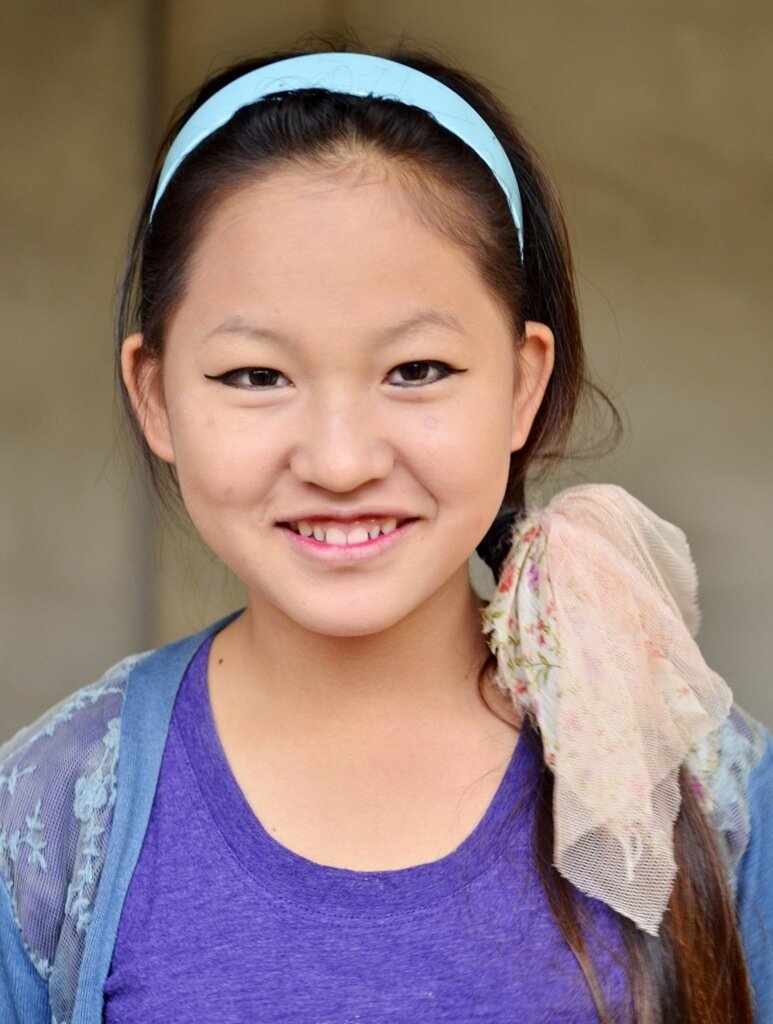 On the way back to town it wasn't leeches that were uppermost in my mind. Or mud. In this town of vastly varying degrees of wealth, at the bottom end Utopia doesn't seem conceivable and Communism doesn't seem to be much of an answer.
On the way back to town it wasn't leeches that were uppermost in my mind. Or mud. In this town of vastly varying degrees of wealth, at the bottom end Utopia doesn't seem conceivable and Communism doesn't seem to be much of an answer.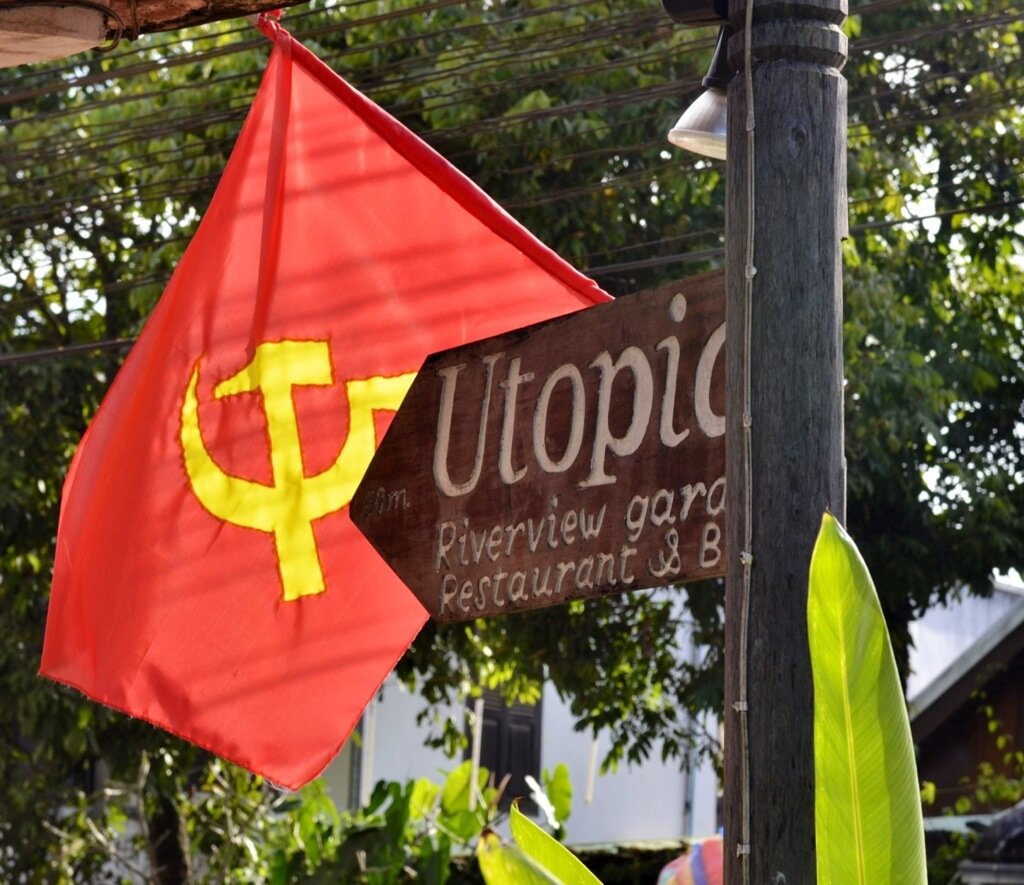 Our quest for lunch took us over the 'little' Bamboo Bridge:
Our quest for lunch took us over the 'little' Bamboo Bridge: David, ever the gentleman, went first - just to make sure...
David, ever the gentleman, went first - just to make sure...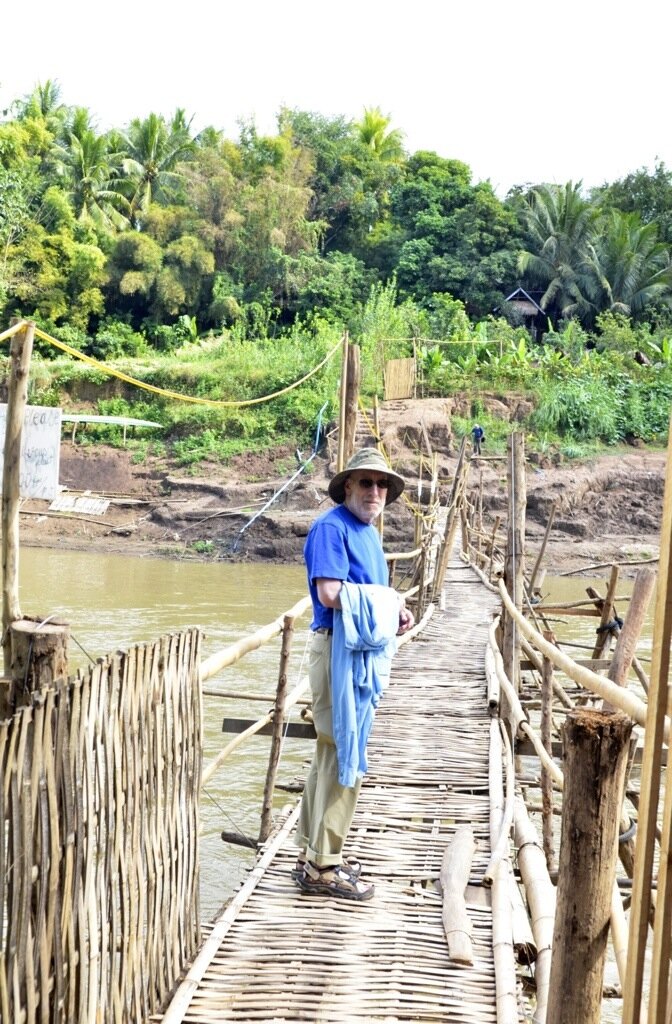 He pronounced it safe for me to cross.
He pronounced it safe for me to cross.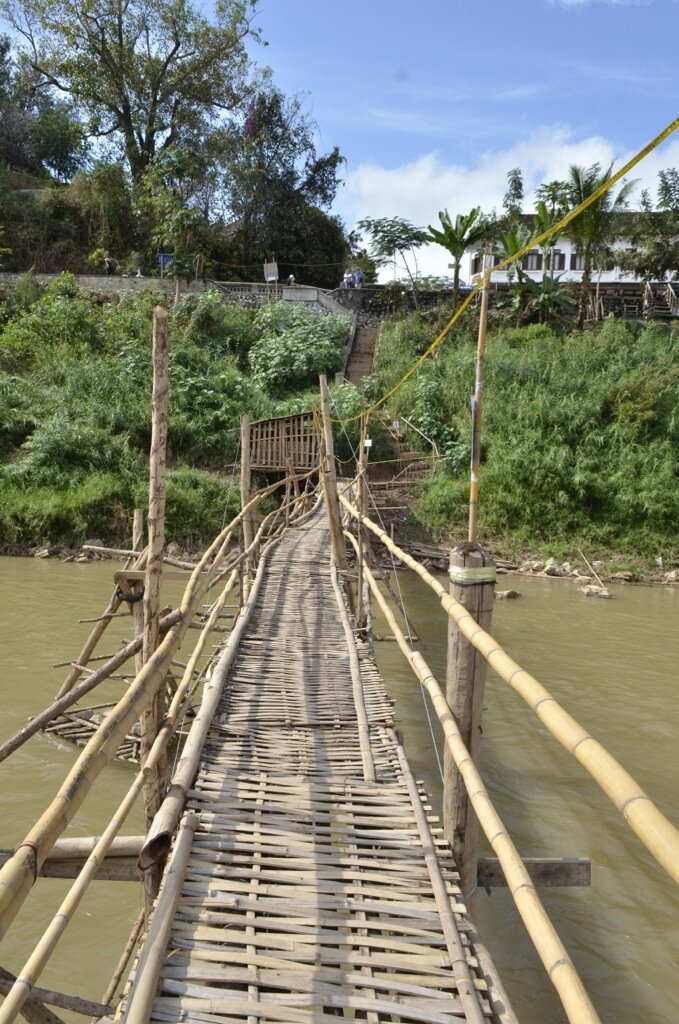 Several of you have asked if I am along on this trip with the much photographed David Brody.Indeed I am - shown here lounging in our tree house nook at the restaurant on the other side of the river:
Several of you have asked if I am along on this trip with the much photographed David Brody.Indeed I am - shown here lounging in our tree house nook at the restaurant on the other side of the river: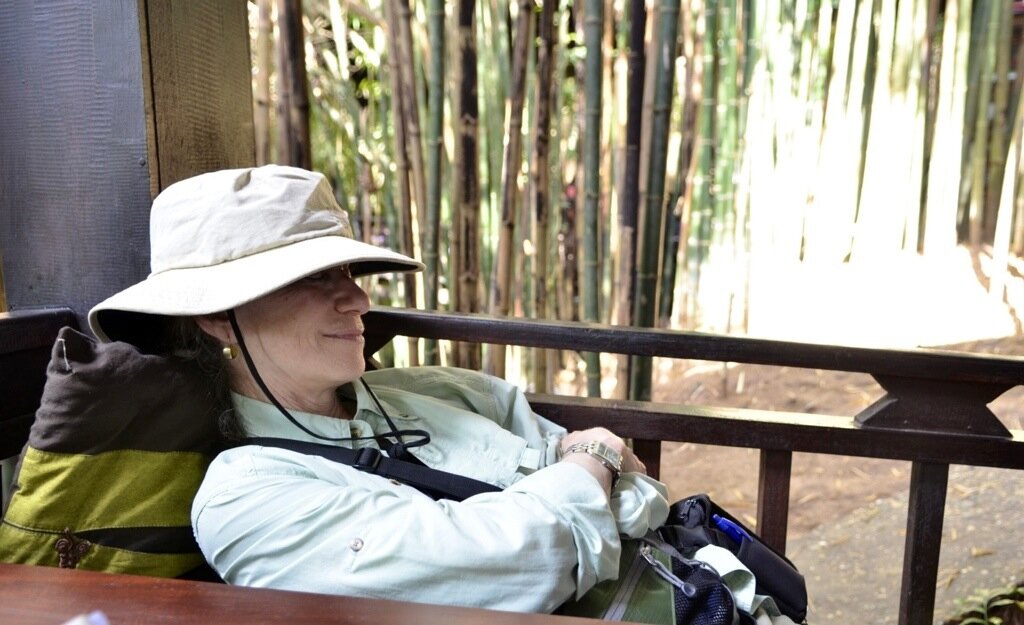 My photography teacher Constantine Manos's most devastating criticism is, "Anyone could have taken that picture." Indeed that is true in Luang Prabang where thousands of Nikon and Canon toting tourists wake at dawn and stream into the center of town on foot and in vans to take pictures of the novice monks as they file out of the monasteries to beg for food for their breakfasts from local people (and tourists) who make offerings of sticky rice and fruit. As darkness turns to dawn and the sky brightens, the sight of the vivid orange robed procession of young men and boys, their heads shaved and eyes downcast, is truly moving - and one hell of a photo op.We avoided the mobs by positioning ourselves several blocks away from the main monastery, and while I know Costa would have said you-know-what, here are my favorites from this morning.
My photography teacher Constantine Manos's most devastating criticism is, "Anyone could have taken that picture." Indeed that is true in Luang Prabang where thousands of Nikon and Canon toting tourists wake at dawn and stream into the center of town on foot and in vans to take pictures of the novice monks as they file out of the monasteries to beg for food for their breakfasts from local people (and tourists) who make offerings of sticky rice and fruit. As darkness turns to dawn and the sky brightens, the sight of the vivid orange robed procession of young men and boys, their heads shaved and eyes downcast, is truly moving - and one hell of a photo op.We avoided the mobs by positioning ourselves several blocks away from the main monastery, and while I know Costa would have said you-know-what, here are my favorites from this morning.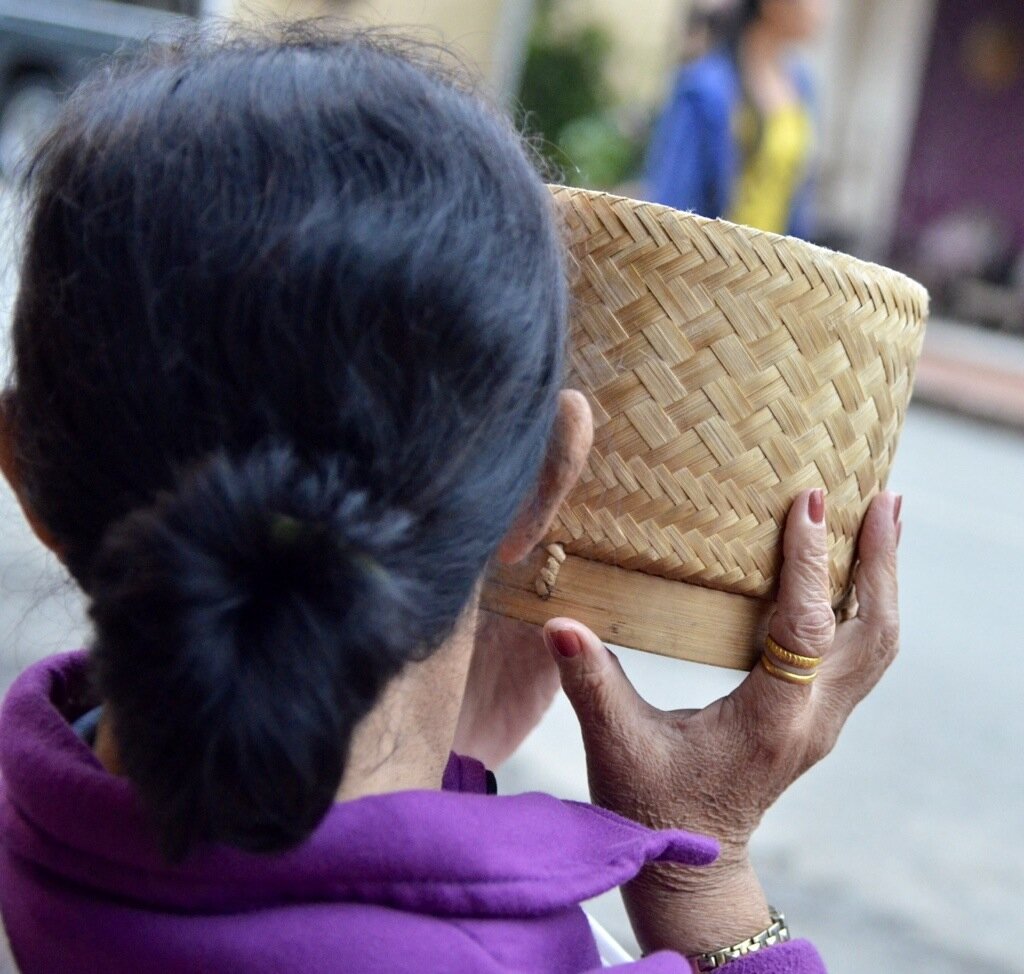
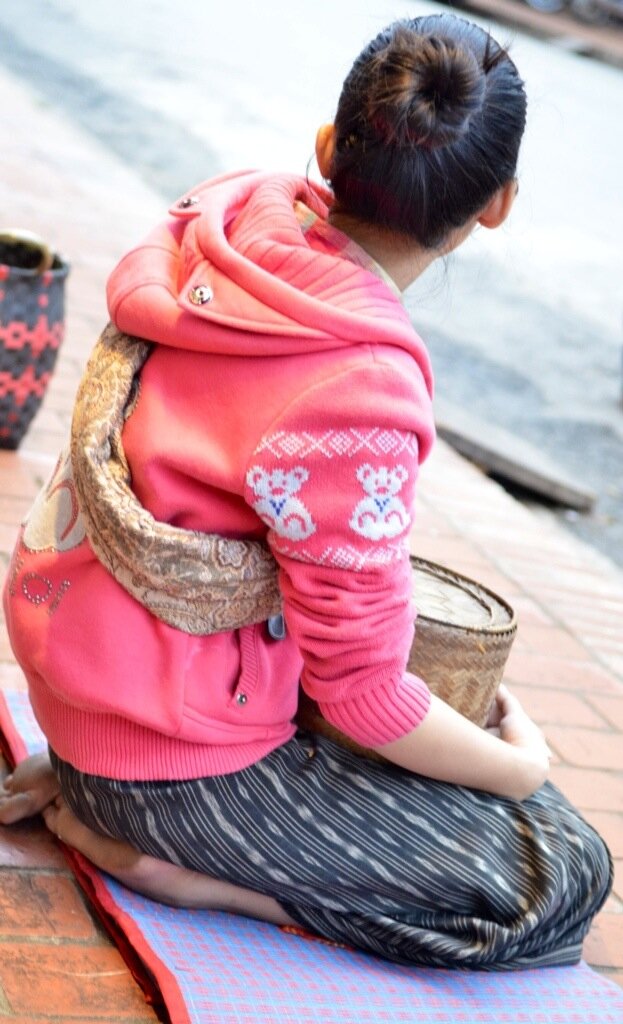
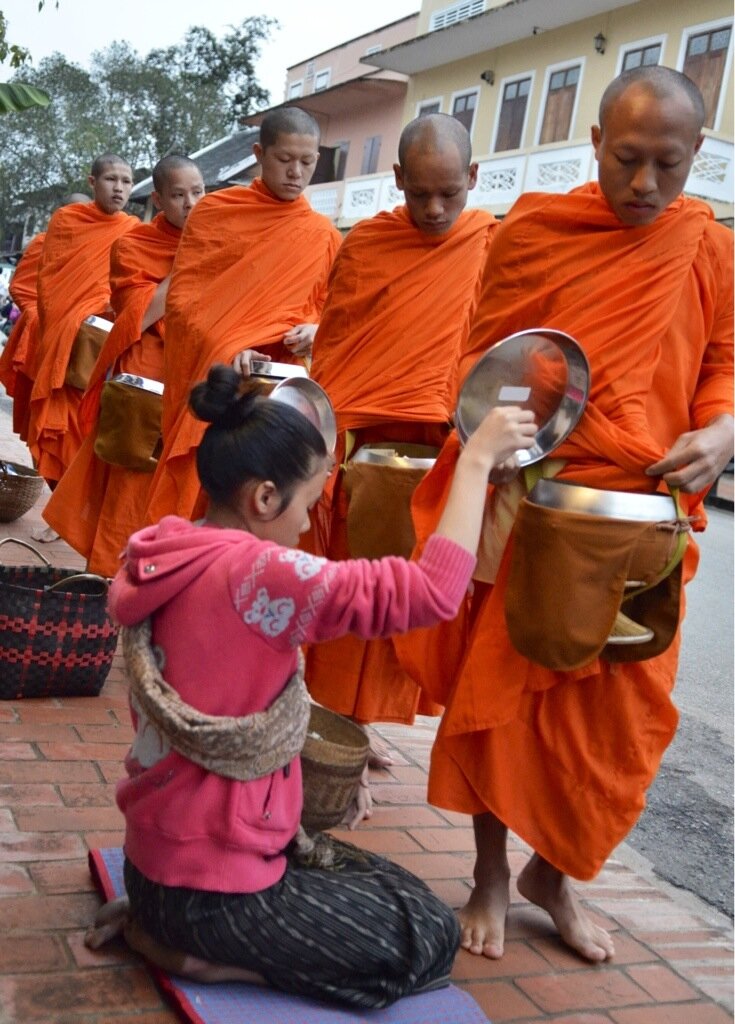
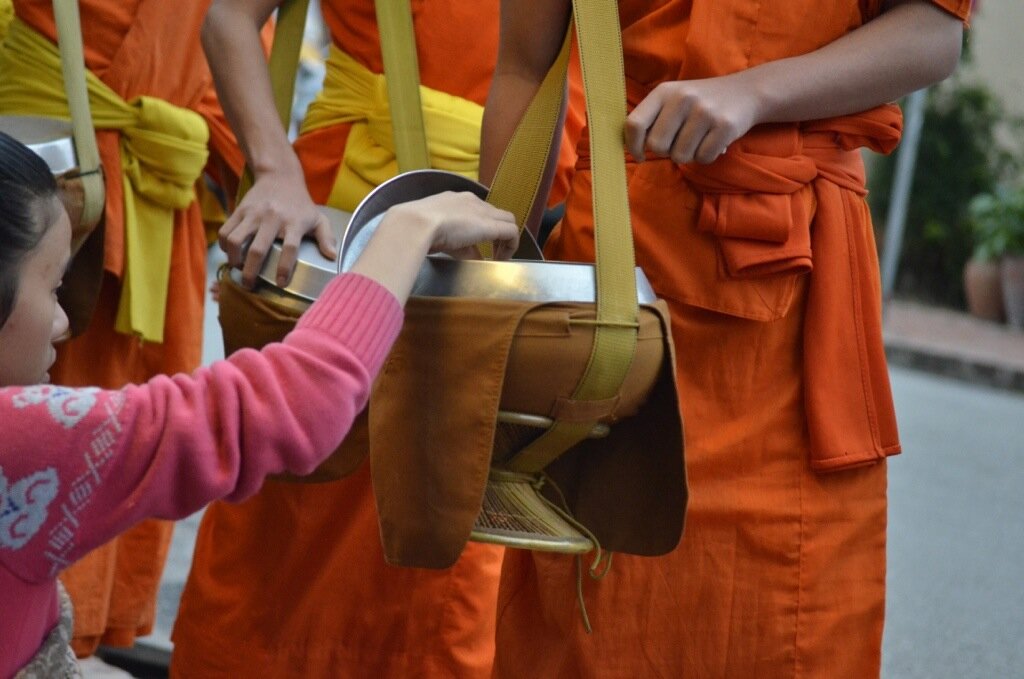
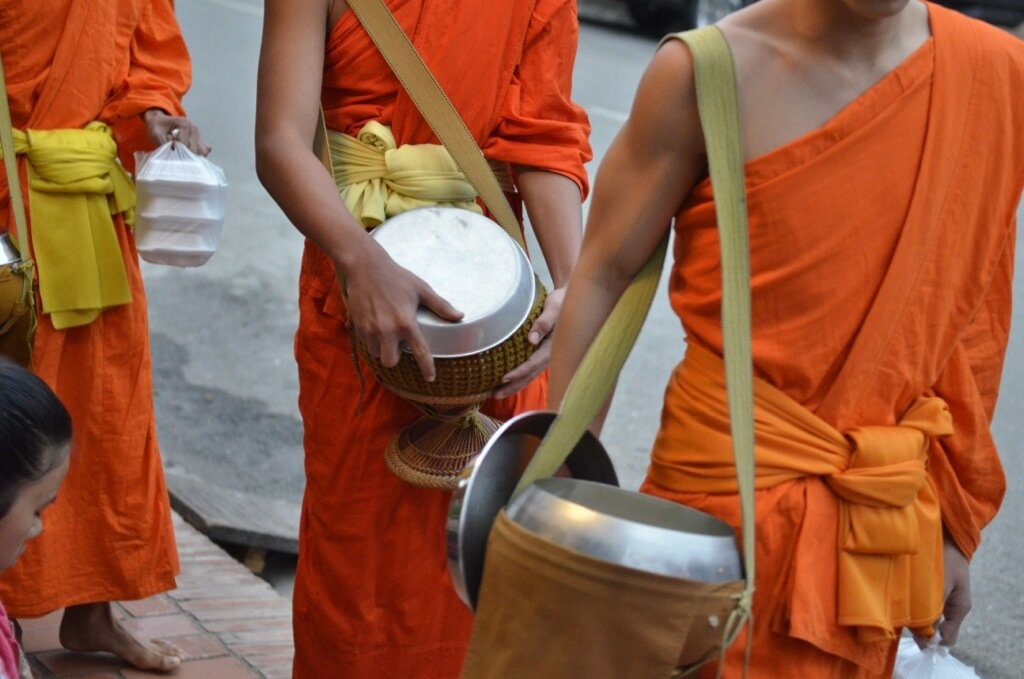
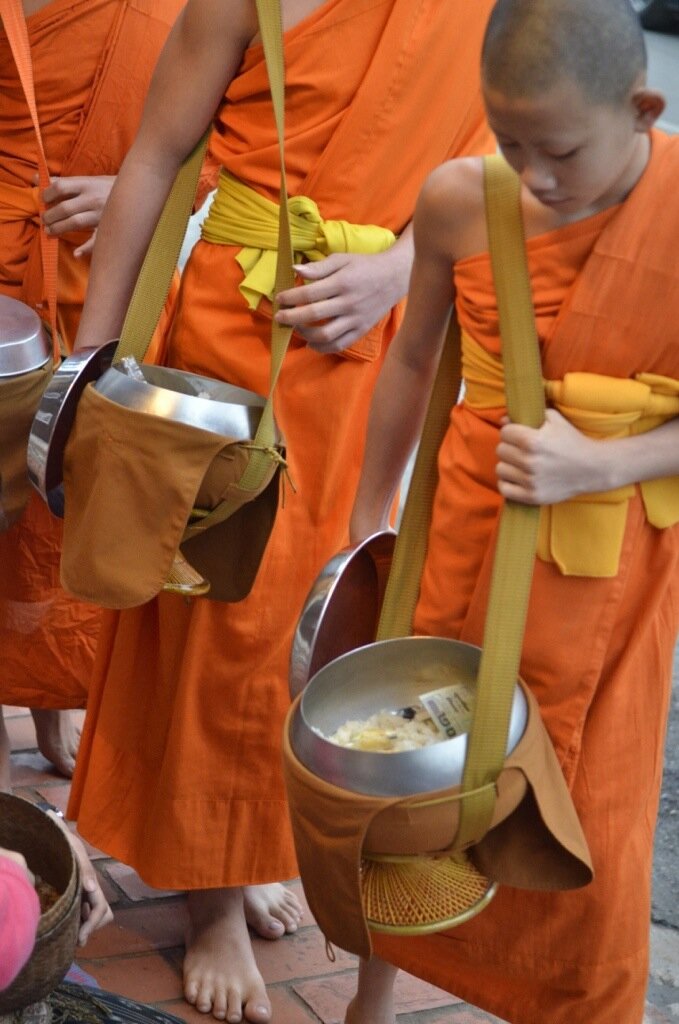
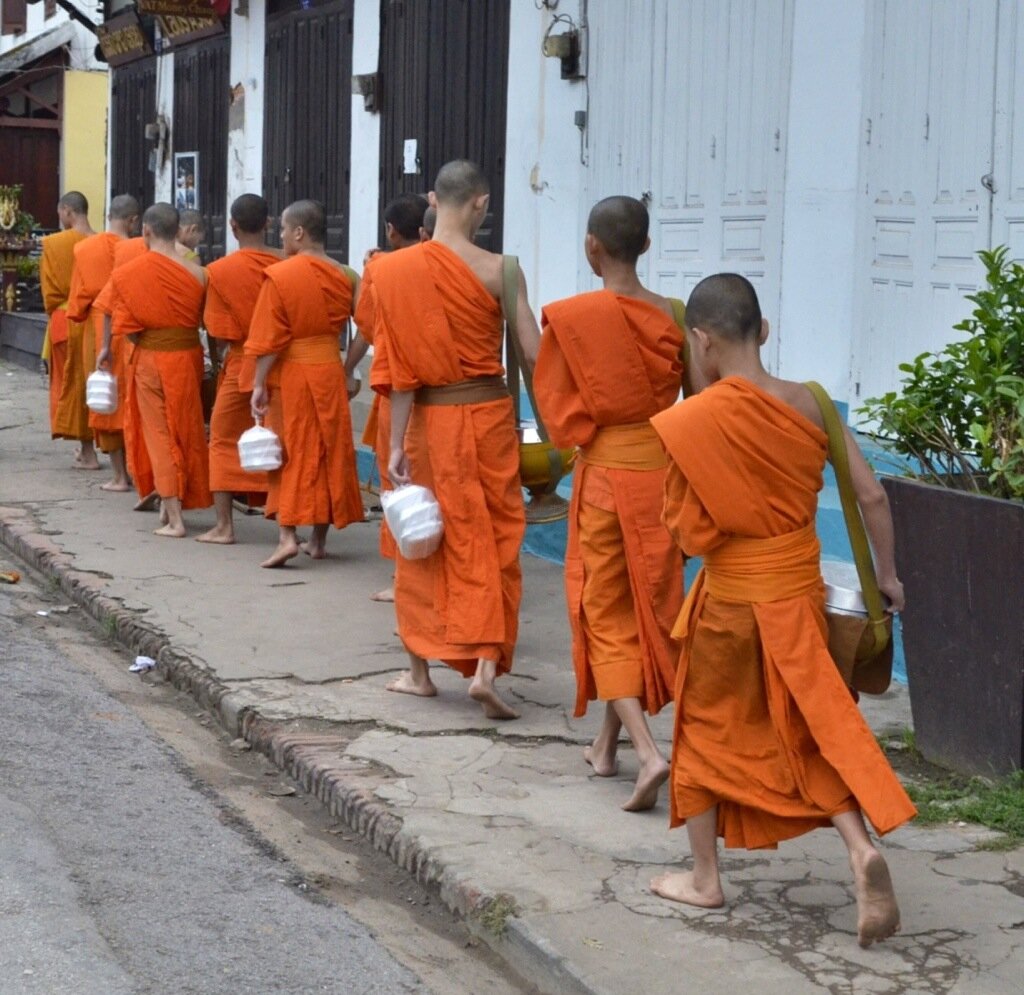 All Buddha's creatures get breakfast.
All Buddha's creatures get breakfast.